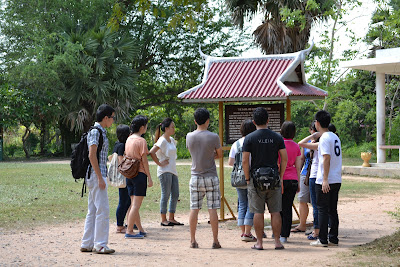Eid Mubarak!
Good Food and Good Company
What a spread!!
This is a great time of the year to reflect on how much the predominately Christian and Jewish West has in common with the Muslim world which extends from Mauritania in West Africa to Indonesia in Asia. With so much talk about a "clash of civilizations" and the supposedly fundamental and irreconcilable differences between societies, it is sometimes helpful to reflect on what we all have in common. Of course, that assumes we actually have something in common. So do we?
Many of my American friends (especially the religious ones) are shocked when they first hear about Eid al Adha or the Feast of the Sacrifice. Eid al Adha is the Muslim holiday that commemorates Abraham's willingness to sacrifice his son to G-d. That's right! Muslims have a holiday to celebrate the events which are unfolded in Genesis 22 (of the Old Testament) and Surah 37:99 (of the Quran). In both versions, Abraham is called to sacrifice his son, takes him to the appointed location, binds him, and lifts a knife to slay him when he is stopped by G-d at the last minute. A test of faith.
To celebrate the miracle of Abraham's faith, Eid al Adha is celebrated each year on a set date on the Islamic lunar calendar. It is a joyous holiday (except for livestock) during which families slay a cow, goat, or sheep and then share the food with family, friends and neighbors, and the needy. That is why it is my favorite holiday - lots and lots of food and happy people. It is also a great opportunity to talk about common ground and common beliefs and is an annual reminder of the foundation that exists for real dialog between those who believe they are the descendants of Abraham.
 |
| Two cows in Kabul in blissful ignorance the day before Eid al Adha |
Abraham as Father of Three of the World's Largest Religions
Just a quick refresher for those of you that have not curled up with your bibles recently. Abraham was not Jewish, Christian, or Muslim. In fact, he really didn't have any religion at all. Since this is probably being read by more Jews and Christians than Muslims I will tell the rest of the story from the perspective of the Old Testament. He was raised in a community that worshiped idols but was called by G-d (Genesis 12) to travel to the land of Canaan where he first established monotheism. Initially, his wife Sarah was unable to bear him a son and Abraham conceived a child with Sarah's servant Hagar. His name was Ishmael. Later, Sarah bore Abraham a son who was named Isaac. After Isaac was born, Sarah tells Abraham to send Hagar and Ishmael away. Abraham is not happy about it - but eventually relents after G-d tells him that they will be taken care of and that, like Isaac, Ishmael will also be father of a nation (Genesis 21:13).
Hagar and Ishmael depart as instructed and end up in a harrowing situation in the desert after running out of food and water. At the edge of death, Hagar left Ishmael alone and sat a short distance away as she could not bear to see him die. At that instant, G-d spoke to Hagar and told her that he would make Ishmael "into a great nation (Genesis 22:18)". When she opened her eyes, G-d had provided her with a flowing well and their lives were saved. Muslims believe the exact same story with a few additional details. Muslims believe the well (called the Zamzam Well) is located in Mecca, Saudi Arabia and it is considered one of the holiest sites in Islam. Millions of Muslims drink from the well each year as they perform their Hajj. Anyone traveling in the Islamic world quickly become accustomed to seeing hundreds of containers of Zamzam water in the checked luggage of pilgrims returning from the Hajj.
 |
| Zamzam water at the baggage claim in Dubai, UAE |
So let me end this blog entry with a trivia question: is there any site in the world where Jews, Christians, and Muslims all worship G-d side by side that is specifically dedicated to Abraham?
**Author's note: There is some disagreement between Islamic religious scholars about whether Abraham was going to sacrifice Isaac or Ishmael. I am NOT a theologian and as far as I can tell there seems to be acceptance in the Islamic world that he was going to sacrifice Ishmael. Other than which son was going to be sacrificed, the test of faith is the same.



.JPG)














.JPG)
.JPG)
.JPG)
.JPG)
.JPG)
.JPG)
.JPG)

















